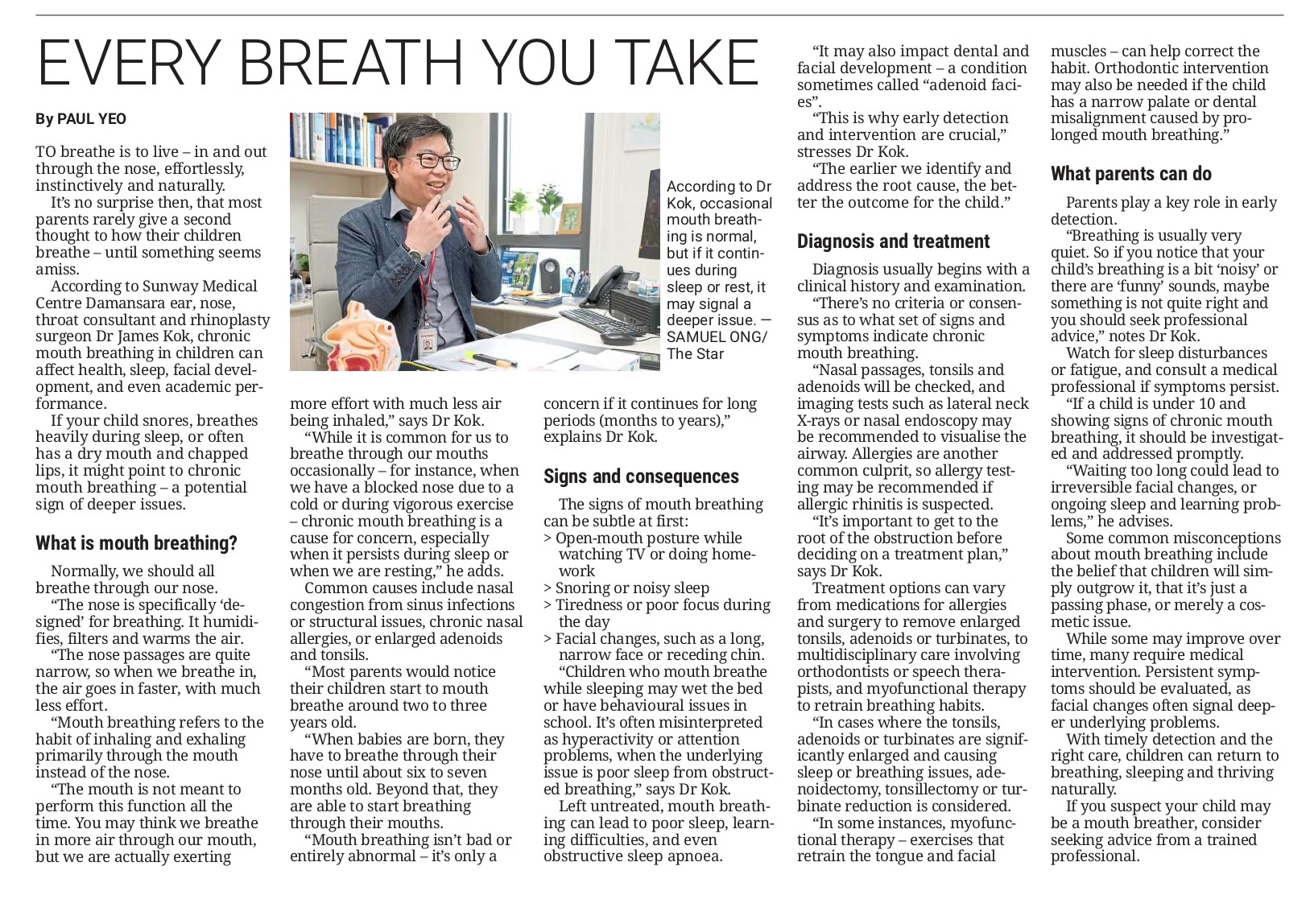03/08/2025
Every breath you take

TO breathe is to live — in and out through the nose, effortlessly, instinctively and naturally. It’s no surprise, then, that most parents rarely give a second thought to how their children breathe — until something seems amiss.
According to Sunway Medical Centre Damansara ear, nose, throat consultant and rhinoplasty surgeon Dr James Kok, chronic mouth breathing in children can affect health, sleep, facial development and even academic performance.
If your child snores, breathes heavily during sleep or often has a dry mouth and chapped lips, it might point to chronic mouth breathing — a potential sign of deeper issues.
What is mouth breathing?
Normally, we should all breathe through our nose.
“The nose is specifically ‘designed’ for breathing. It humidifies, filters and warms the air. The nose passages are quite narrow, so when we breathe in, the air goes in faster, with much less effort.
“Mouth breathing refers to the habit of inhaling and exhaling primarily through the mouth instead of the nose. The mouth is not meant to perform this function all the time. You may think we breathe in more air through our mouth, but we are actually exerting more effort with much less air being inhaled,” says Dr Kok.
“While it is common for us to breathe through our mouths occasionally — for instance, when we have a blocked nose due to a cold or during vigorous exercise — chronic mouth breathing is a cause for concern, especially when it persists during sleep or when we are resting,” he adds.
Common causes include nasal congestion from sinus infections or structural issues, chronic nasal allergies or enlarged adenoids and tonsils.
“Most parents would notice their children start to mouth breathe around two to three years old. When babies are born, they have to breathe through their nose until about six to seven months old.
“Beyond that, they are able to start breathing through their mouths. Mouth breathing isn’t bad or entirely abnormal — it’s only a concern if it continues for long periods (months to years),” explains Dr Kok.
Signs and consequences
The signs of mouth breathing can be subtle at first:
- Open-mouth posture while watching TV or doing homework
- Snoring or noisy sleep
- Tiredness or poor focus during the day
- Facial changes, such as a long, narrow face or receding chin
“Children who mouth-breathe while sleeping may wet the bed or have behavioural issues in school. It’s often misinterpreted as hyperactivity or attention problems, when the underlying issue is poor sleep from obstructed breathing,” says Dr Kok.
Left untreated, mouth breathing can lead to poor sleep, learning difficulties and even obstructive sleep apnoea. It may also impact dental and facial development — a condition sometimes called "adenoid facies".
“This is why early detection and intervention are crucial,” stresses Dr Kok. “The earlier we identify and address the root cause, the better the outcome for the child.”
Diagnosis and treatment
Diagnosis usually begins with a clinical history and examination.
“There’s no criteria or consensus as to what set of signs and symptoms indicate chronic mouth breathing. Nasal passages, tonsils and adenoids will be checked, and imaging tests such as lateral neck X-rays or nasal endoscopy may be recommended to visualise the airway.
“Allergies are another common culprit, so allergy testing may be recommended if allergic rhinitis is suspected. It’s important to get to the root of the obstruction before deciding on a treatment plan,” says Dr Kok.
Treatment options can vary from medications for allergies and surgery to remove enlarged tonsils, adenoids or turbinates to multidisciplinary care involving orthodontists or speech therapists and myofunctional therapy to retrain breathing habits.
“In cases where the tonsils, adenoids or turbinates are significantly enlarged and causing sleep or breathing issues, adenoidectomy, tonsillectomy or turbinate reduction is considered.
“In some instances, myofunctional therapy — exercises that retrain the tongue and facial muscles — can help correct the habit. Orthodontic intervention may also be needed if the child has a narrow palate or dental misalignment caused by prolonged mouth breathing,” Dr Kok adds.
What parents can do
Parents play a key role in early detection. “Breathing is usually very quiet. So if you notice that your child’s breathing is a bit ‘noisy’, or there are ‘funny’ sounds, maybe something is not quite right and you should seek professional advice,” notes Dr Kok.
Watch for sleep disturbances or fatigue and consult a medical professional if symptoms persist.
“If a child is under 10 and showing signs of chronic mouth breathing, it should be investigated and addressed promptly. Waiting too long could lead to irreversible facial changes or ongoing sleep and learning problems,” he advises.
Some common misconceptions about mouth breathing include the belief that children will simply outgrow it, that it’s just a passing phase or that it’s merely a cosmetic issue.
While some may improve over time, many require medical intervention. Persistent symptoms should be evaluated, as facial changes often signal deeper underlying problems.
With timely detection and the right care, children can return to breathing, sleeping and thriving naturally. If you suspect your child may be a mouth breather, consider seeking advice from a trained professional.
Source: The Star Online Newspaper
Back


